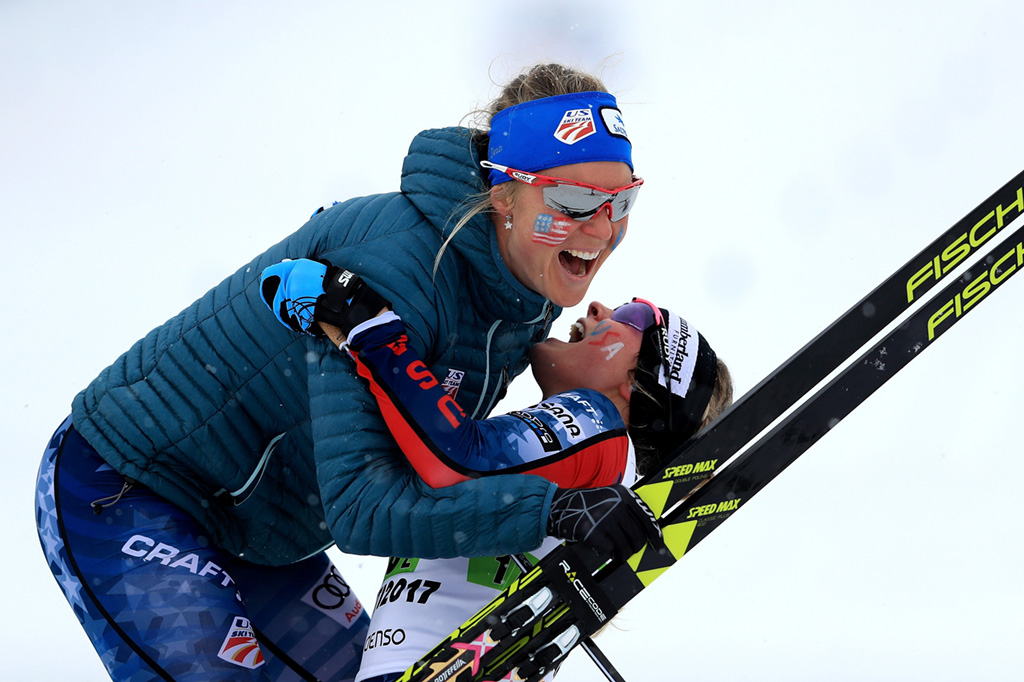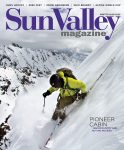It was snowing lightly at the start of the women’s team sprint event of last year’s World Cross-Country Skiing Championships in Lahti, Finland. Nearly 15,000 people packed the Lahti ski stadium and held forth with a frenzied passion perhaps hard for Americans to truly appreciate. Think of the thunderous “yellow wall” of Germany’s Dortmund soccer fans and you’ll begin to get the picture. Among the thousands of screaming fans, coaches, wax technicians, support staff, and athletes in the Lahti stadium, there were probably only two people who had an inkling of what was about to unfold.
U.S. skiers Sadie Bjornsen and Jesse Diggins inched up to the start of the classic sprint relay—a torturous event in which each skier of a two-person team alternates skiing three 1.3-kilometer legs at a full sprint. Given the magnitude and intensity of the scene, it would be easy to miss the fact that they were wearing the “magic relay socks”—red-and-white-striped sock on the right foot, blue-and-white-striped sock on the left—that look a little like they came out of a children’s costume box.
Bjornsen rocketed out of the start and held the lead for the entire first lap, even leading Norwegian Heidi Weng, the number one overall skier on the World Cup circuit. By her third lap, Bjornsen had dropped to third but left Diggins in contention for the bronze medal. As the last lap of the race unfolded, Diggins dropped to seventh. But then on the last hill of the course Diggins surged to fourth, just on the shoulder of the world’s best classic sprint finisher, Sweden’s Stina Nilsson. With 100 meters to go, the two skiers were side-by-side, fiercely double-poling in sync, pushing each other to the extreme of what a human body can do. At the end of what had to be the longest, most painful 100 meters of her life, Diggins stretched out her leg at the line and nipped Nilsson by 0.19 seconds. Before Diggins could collapse to the snow in exhaustion, Bjornsen was there at the finish line to catch her partner in her arms.

Sadie Bjornsen catches collapsing skier Jesse Diggins after she outsprinted Sweden’s Stina Nilsson to win the bronze medal at the 2017 FIS World Ski Championships. Photo by Richard Heathcote / Staff / getty images
It was a historic performance; never had American skiers won a World Championships medal in a classic technique race, an event Scandinavian countries have dominated since people began racing on cross-country skis. And just three days earlier, Diggins and Kikkan Randall, an enduring superstar for the U.S., garnered a silver and bronze, respectively, in the individual sprint event. It was the first time the U.S. had won three medals at a World Championships.
Amid the pandemonium of the relay finish was Chris Grover, the even-keeled, quick-to-smile yet fiercely competitive head coach of the U.S. cross-country team. It was, Grover recently told me at his Hailey, Idaho, home, one of the proudest moments in his now seven-year tenure at the helm of the U.S. team.
Andy Newell, who has three World Cup podiums (first, second, or third place) to his name, joined the U.S. Ski Team (USST) when he was a senior in high school and is now racing on the international stage for his 17th year. Almost all that time Grover has been his coach in one capacity or another. I talked to him during a USST training camp in Park City, Utah. “Probably nobody in the U.S., or anywhere, has been more responsible for how far the U.S. team has come,” Newell said. “He’s put in the most time. He’s been with us for this whole process, which has been an exciting one … Back in 2003, 2004, it was a huge, successful day on the World Cup if we were to get a top 10, or a top 20.”
Medals Matter
Grover is the first to point out that medals matter. “Our basic objective is to win medals at the Olympics and World Championships,” Grover said. “It’s pretty cut and dried … That’s my job description, to win medals at the absolute highest levels.”
And the U.S. has been doing just that under Grover.
Beginning in 2006, with Newell’s first World Cup podium, the Americans have increasingly made their way to World Cup podiums. Simi Hamilton had two podiums in 2016 and one in 2017. On the women’s side, Kikkan Randall alone has upwards of 27 podiums and three World Championship medals since she joined the team in 2000. An illustration of the depth of the women’s team is that last year six different women were on the podium for World Cup races. At the 2013 World Championships, the U.S. women won one medal (gold in team sprint); in 2015, the team took home two medals; and last year they garnered the historic three medals. From an international ranking of
17th 10 years ago, the U.S. has moved into the top six countries in the world.
The Mighty Scandinavians
To appreciate the tremendous gains the U.S. has made, one has to understand the degree to which the Scandinavian countries, and Norway, in particular, have dominated the sport since people first began to race competitively. Consider Olympic medals as a yardstick, for example. Since the first winter Olympics in 1924, 471 medals have been given out in Nordic skiing; 257 have gone to Norway, Sweden, or Finland. Another 101 have gone to the Soviet Union or Russia (which, incidentally, has been implicated in a wide-reaching, state-sponsored doping scheme of late). In sum, approximately 76 percent of all medals over nearly 100 years have gone to those four entities. And even among those powerhouses, Norway stands considerably above the rest.
“Norway is an interesting model,” Grover said. “They are the absolute pinnacle of the sport. They demonstrate what the best of the sport looks like.” He pointed out that while Norway’s population is only five million, cross-country skiing is the country’s most popular sport. As a result, and due to a great deal of media attention, the national cross-country team attracts the very best athletes of those five million people. In addition, it has a big budget—Grover estimates that it is 15 times the U.S. budget. “They can support more athletes at a higher level … support them with more staff, more camps, testing opportunities, more specialists, whether nutritionists, sports psychologists, physicians, or service teams,” Grover explained. “They have this incredible infrastructure that supports them at all key levels … They are also doing an excellent job of coaches’ education … and retaining athletes.
“It’s easy to say, ‘How are we ever going to compete with that?’ But the leaders of the Norway program are very transparent and open and willing to share information. We have a great relationship with them—if we need help, or want to learn about what they’re doing.”
Building the Pyramid
Grover, who is 46 and a native of Alaska, grew up ski racing. He excelled academically and athletically at West Anchorage High School, earning admission to Dartmouth College in 1989. After four years of racing for Dartmouth, Grover went on to coach at Stratton Mountain School—a renowned cross-country powerhouse. With coaching stints for the Sun Valley and the Mount Bachelor teams, Grover was hired as an assistant coach for the U.S. Ski Team (USST) in 1999. He went on to head the Development Team for two years, serve as the sprint coach from 2006 to 2010, and then assumed the head coaching job in 2010. Despite his far-flung traveling responsibilities, Grover is a regular with his wife, Svea, on the sidelines of their girls’ soccer games and Nordic races.
While at West Anchorage High, Grover was coached by Rick Kapala, now the director of the cross-country program of the Sun Valley Ski Education Foundation (SVSEF), and who, not incidentally, has three times been named Coach of the Year by the U.S. Ski and Snowboard Association, the parent organization of the USST and U.S. Olympic Team. Remarkably, 32 years after coaching Grover, Kapala is now coaching Grover’s two daughters. This fact illustrates a point Kapala makes as to one reason the U.S. team is having such great success. “What’s happened is that we are now stacking generations of skiers on top of each other,” he explained. “People like Jesse Diggins, Kikkan Randall, and Andy Newell grew up being cross-country skiers partly because their parents were cross-country skiers. The pyramid is getting built.”
A Different Model
From the beginning, Grover realized he needed to take an approach different from many of the other, albeit successful national teams like Norway and Sweden. “One of our challenges is that our nation is five time zones wide, from Alaska to New England,” Grover explained. “Nobody that we compete against deals with that, except Russia, which has a very enclosed program.
“What we’ve done in the U.S. is to realize that it’s not going to work to have a [centralized] program like that. For us to be successful, we need to have a cooperative, collaborative program with all the different clubs that these athletes come from … First, we don’t have the money to pull people together for a camp every two weeks, nor would it be beneficial for the athletes to have to go across four or five time zones every few weeks. If you live in Norway, you’re on one time zone; you can come together every three weeks for a camp … because the farthest you might have to travel is to fly for two hours. So, we have to have a totally different model.”
The approach Grover has taken has been to leverage all of the resources we have as a nation. “That means involving all of the clubs and personal coaches of our athletes, inviting clubs to participate with the national team, being as inclusive as possible while still being focused on that end goal of winning medals.”
He also points to the “stability” of the program from year to year as being key to the recent success of the team. “It’s not because we have staff or coaches that are more talented than the people we’re competing against … In my opinion, it is because we have created a stable platform—the same staff, coaches, some of the same camps—so that the athletes can incrementally build their training and experience from year to year.”
Matt Whitcomb, USST women’s head coach, explained in practical terms what that stability really means: “Chris may be the most professional ski coach on the World Cup. He is organized and sharp, and manages logistics wisely. He has always been that guy we can count on to negotiate the intricate maze of traveling the World Cup circuit, and he can do it without getting stressed. Logistical chaos is something we don’t experience, and I can’t emphasize [enough] what a positive impact this has on our team. Unfortunately for Chris, what I’ll remember is the time he put
gas in our diesel van.”
The Secret Weapon
Perhaps Grover’s secret weapon is, ironically, his emphasis on team dynamics and cohesion in a sport that, on the surface, is the quintessential individual sport. Newell pointed out that, before Grover, the U.S. had several foreign coaches that “weren’t as emotionally invested as an American coach with American skiers and didn’t have the sense of stability and long-term goals and U.S. pride that Grover brought.”
That emotional investment can be witnessed every day during training. As Coach Whitcomb observed, “What sets Chris aside from many other head coaches is that he likes to get out and coach the athletes, too. He’s out skiing with them, holding a video camera while shivering in the rain, or managing skis in the exchange zone during a team sprint. Chris is a great coach with an eye for technique and a broad understanding of training.”
Cross-country skiing is unusual among individual sports in that it exists on the professional level as a team sport, explained SVSEF’s Kapala. Skiers on the U.S. team—men and women—train, race and travel together for a solid five to six months during the World Cup season, which, in itself, presents a coaching challenge. “Chris blends two things,” said Kapala. “He communicates really well with the individual athletes while managing the whole … Everybody on the team is unique with individual needs—Jesse Diggins and Liz Stephen are uniquely different—yet Chris sets the tone for an effective and professional team environment where everybody feels supported, and one in which athletes buy into the success of the larger group. That’s not an easy thing to do.”
Newell noted that when Grover took over in 2010, he and the other coaches invested a lot of time in team building and team bonding. The men’s and women’s teams often train together, a practice unique among the other national teams. “We are a group of athletes that are kind of like one big family,” Newell said. “We travel around the world together and spend more time together than any other national team. There has been an emphasis on working together as a team to improve and be a cohesive unit throughout our training and racing.”
The strategy seems to work. After Diggins made her dramatic sprint, edging out Stina Nilsson at the World Championships, a Finnish journalist asked her about the crazy striped socks the relay team wears. “These socks are magic!” Diggins said with her seemingly ever-present enthusiasm and infectious smile. “It is this belief that the whole team is with you. When you wear these socks, you have the energy of the entire Team USA.”
Perhaps it’s another sports superstition. However, the belief and the inspiration is real and clearly manifests itself in performance. “The team atmosphere that we’ve been able to create and foster is one of the main reasons we’ve had success and that we’ve been able to retain athletes as long as we have,” Grover observed. “The family feel of the program, the positive, nurturing atmosphere … has allowed us to compete with nations for whom cross-country racing is a bigger cultural phenomenon.”
That theme carries over into the staff and support system for the skiers. One of Grover’s favorite quotes is a mantra of New Zealand’s All Blacks rugby team, the winningest team in sports history: “Better people make better All Blacks.” It speaks to the personality, work ethic and type of person he hires on the staff. “We can teach anybody the basics of cross-country skiing and physiology and everything that goes along with it. You can’t teach being a good person. You can’t teach looking out for other people. Well, you can, but it’s much harder.”
Identifying Talent
For even elite athletes, cross-country ski racing is one of the most demanding competitions in the world. For one, athletes must master two distinct techniques, freestyle and classic. Then they must be able to compete in sprints—which typically involve several 1.2-kilometer (women) and 1.4-kilometer (men) laps—as well as in distance races (30 and 50 kilometers, respectively). To boot, there are individual events and relay events, the latter of which require team coordination, timing, and commitment.

From left: Coach Chris Grover, Jesse Diggins, Sadie Bjornsen, Liz Stephen, Kikkan Randall, and coach Matt Whitcomb celebrate at the 2017 FIS World Ski Championships. Photo courtesy U.S. Ski Team
The question becomes: How does one identify talent—skiers who will succeed at the highest level? In discussions with physiologists, Grover is often asked why he doesn’t have better talent identification programs. Why doesn’t he take 15-year-olds, put them on a treadmill and look for kids with massive VO2 max results? (A VO2 max test essentially measures the maximum rate at which someone can process oxygen and thereby generate cellular energy.) The reason, Grover said, “…is that so many factors go into making a successful cross-country skier: not only VO2 max, but anaerobic threshold, general strength, specific strength, and mental toughness—that is critical. If you aren’t willing to dig deep and aren’t ultra-competitive, it won’t happen at the highest levels. Also, it matters how technically efficient you are, and how you balance the stress: work, school, skiing, relationships.
“At the end of the day, the best talent identification that we have is race results, because in racing, that’s where the athlete has to bring it all together.”
In 1996, Nike famously recruited one of the world’s greatest marathoners, Philip Boit, of Kenya, to see if they could turn him into an Olympic cross-country skier. “Great guy, massive VO2 max but was tens of minutes behind in races,” said Grover, who worked some with Boit on his technique. “He just hadn’t picked up the technical skills at a young age: the ability to ride a flat ski, to feel a wax pocket, to feel the edging, to apply power efficiently. It’s very difficult. You can spend a lifetime doing it and not master it.”
That being said, Grover stresses how basic the technique is that they are working on with the national team. “People would be surprised … It’s how to herringbone efficiently, where is your weight when compressing on the kick on a classic ski … It is absolutely basic, but I guess that would be part of my philosophy. It doesn’t have to be complicated; in fact, you make more progress when it’s simple.”
The Slow Build
While cross-country skiing at the highest levels requires tremendous technical mastery, it, like other endurance sports, requires an enormous accumulation of training hours. Typically, at the elite level, skiers will need to be training from 900 to 1,000 hours per year, which boils down to nearly three hours a day, 365 days per year. Of course, that doesn’t take into account sick days, travel days or other disruptions, all of which, obviously, would add to the daily training load. A critical fact is that one must attain those levels gradually over time.
By way of illustration, Grover explained that a serious high school skier might train 550 hours per year, but to get to the elite level of training, he or she would have to build those training hours over years. “If you don’t build up in a really orchestrated way,” Grover said, ”you will probably severely over-train, perhaps get chronic fatigue syndrome, and eventually put yourself in a position to end your career.”
“A key element to what makes a great cross-country ski racer is the ability to absorb training. There are not many people in the world that can withstand 900 hours of cross-country ski training in a year… And not only withstand it, but benefit from it. The idea of the training is to make you faster in ski racing. Some people might be able to train 800 hours, but it will make them slower. A lot of people’s bodies just break down, with illness, fatigue, injury.”
One of the best skiers in the world, Martin Sundbey of Norway, trains 1,100 to 1,200 hours per year (4-6 hours per day). Sundbey, Grover said, has an extraordinary ability to train hard and absorb it. It is a quality that is, at least partly, genetically driven.
In his book “The Sports Gene,” David Epstein details a 2011 finding of the HERITAGE Family Study, which was a generational study that looked at how regular exercise affected previously untrained people. Specifically, the researchers looked at the effect of exercise on improving aerobic capacity (VO2 max), a key factor in endurance sports like cross-country skiing.
The study revealed wide-ranging results: 15 percent of the subjects exhibited no improvement after five months, while another 15 percent showed greater than 50 percent improvement in aerobic capacity. What’s more, researchers found that families responded similarly; that is, those in the study that were related had similar aerobic benefits. Through statistical and genetic analysis, the researchers found that 50 percent of a subject’s ability to improve aerobic capacity was determined solely by a genetic component; that is, one’s parents. Further, the researchers were able to pinpoint 21 genetic variations that played a crucial role in how “trainable” a person was.
Pyeongchang, 2018
While it seems athletes at this elite level are constantly training, there are, in fact, designed cycles to their regimes. The overarching cycle is the four-year Olympic Games cycle, which comes around this February (Feb. 9–25, 2018) in Pyeongchang, South Korea. The World Championships are held every two years (offset from the Olympics), and the World Cup season runs annually November through March.
For the Olympics, the International Ski Federation (FIS) allocates each nation a set number of spots (up to a maximum of 20 athletes, men and women combined) for the cross-country events. Unlike other leading Olympic teams that are chosen by a national coach, the U.S. Olympic Team is determined almost exclusively by race results. There are two primary routes to the Olympic team: successful results on the European World Cup circuit, or top results in the domestic race circuit known as the Super Tour and at the U.S. National Championships. There is also a provision for discretionary choices by the coach, but it is rarely used.
“Hopefully, this will be my fourth Olympics,” offered Newell. “I’ve said this every time, but this is by far the strongest team we’ve ever had … I think we’re going to be disappointed if we don’t win a medal as a team … A lot of us want it to be us, but, at the same time, we don’t care who it is. If the team wins an Olympic medal, it’s a medal for everyone. It’s a medal for Chris Grover, it’s a medal for the U.S. Ski Team, it’s a medal for everyone. And that’s something Chris has taught us along the way and something that we embrace and something that I think will help us be successful in this Olympic year.”
For coach Whitcomb, who will be coaching alongside Grover in Pyeongchang, the personal is intertwined with the professional. It is this nature of American teams that often distinguishes them from others on the international stage. “Being someone’s boss and friend is a delicate dance, and Chris has always first been my friend,” said Whitcomb. “He’s the guy that makes working long stretches manageable because he can laugh at the stresses and keep the environment light when stresses climb. Chris can laugh at adversity, frequents self-deprecating behavior, and at the end of a long day is still the guy who wants to hang out over a beer and decompress. The average age on our team, of both athletes and coaches, is increasing because nobody wants to retire. And while that may sound like a funny impact Chris has had on the team, it’s perhaps the one thing that has had the biggest impact on our success in the last decade.”


